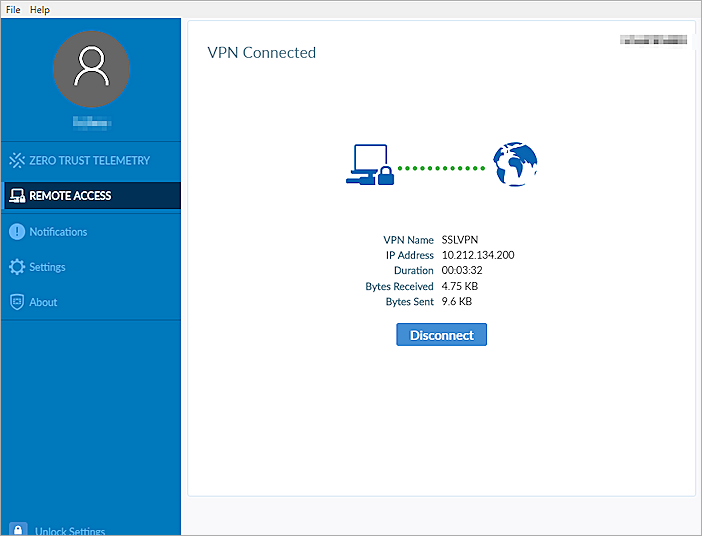Deployment Overview
This document describes how to set up multi-factor authentication (MFA) for Fortinet® SSL VPN with AuthPoint as an identity provider. Fortinet SSL VPN must already be configured and deployed before you set up MFA with AuthPoint.
Fortinet SSL VPN can be configured to support MFA in several modes. For this integration, we set up SAML with AuthPoint.
This integration was tested with v7.0.0 build0066 of FortiGate 60E.
Fortinet SSL VPN Authentication Data Flow with AuthPoint
AuthPoint communicates with various cloud-based services and service providers with the SAML protocol. This diagram shows the data flow of an MFA transaction for Fortinet SSL VPN.
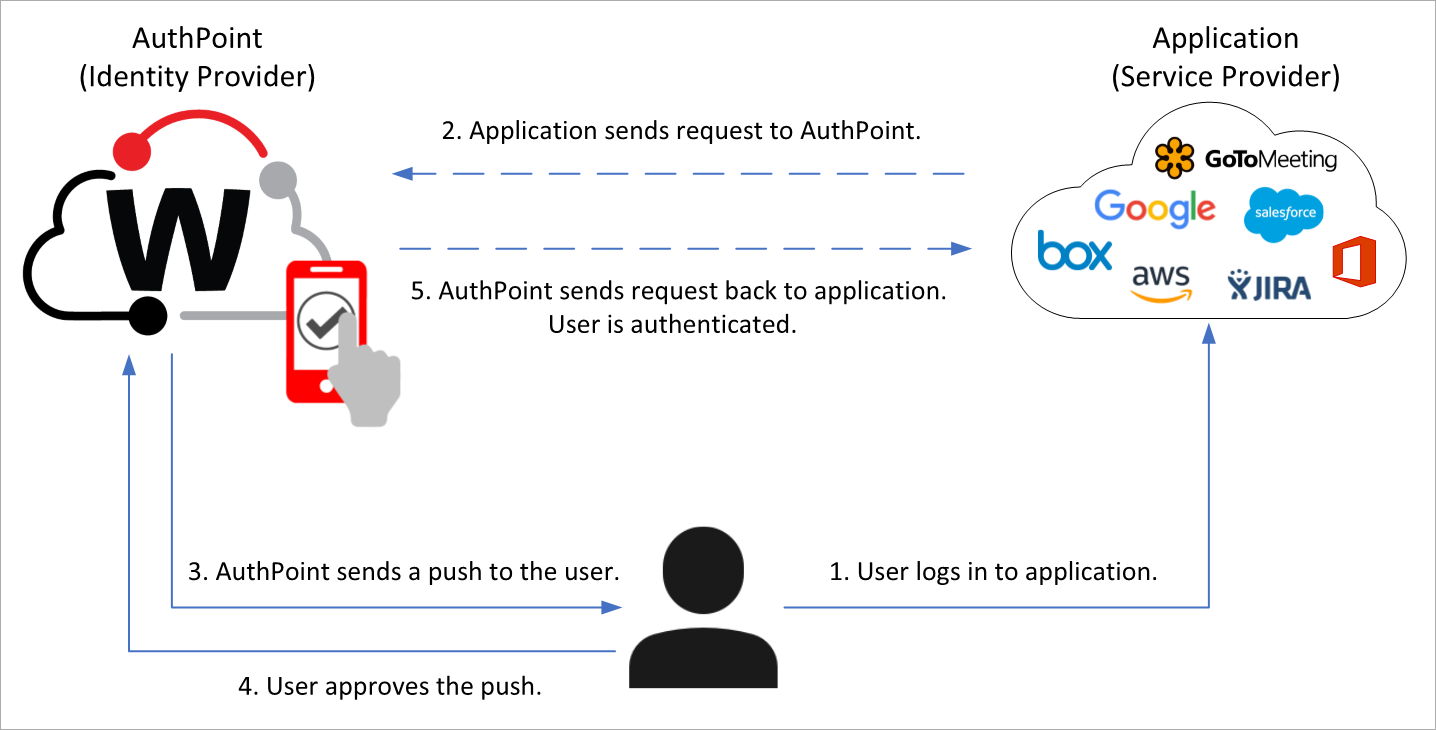
Before You Begin
Before you begin these procedures, make sure that:
- End-users can log in to FortiGate 60E web UI
- You have a FortiClient 6.4.3 or higher
- A token is assigned to a user in AuthPoint
- You have an AuthPoint identity provider (IdP) certificate (go to Certificate Management)
Configure Fortinet FortiGate SSL VPN
To start, you must download the metadata file from the Certificate Management page in the AuthPoint management UI. After you have that, you can configure Fortinet SSL VPN.
- Log in to WatchGuard Cloud.
- From the navigation menu, select Configure > AuthPoint. If you have a Service Provider account, you must select an account from Account Manager.
- Select Resources.
- Click Certificate.

- Next to AuthPoint certificate you will associate with your resource, click
 and select Download Certificate and Download Metadata. We recommend that you choose the certificate with the latest expiration date. If you do not have a certificate, or if all of your certificates have expired, click Add Certificate and use the newly created certificate.
and select Download Certificate and Download Metadata. We recommend that you choose the certificate with the latest expiration date. If you do not have a certificate, or if all of your certificates have expired, click Add Certificate and use the newly created certificate.The AuthPoint metadata provides your resource, in this case Fortinet SSL VPN, with information necessary to identify AuthPoint as a trusted identity provider.
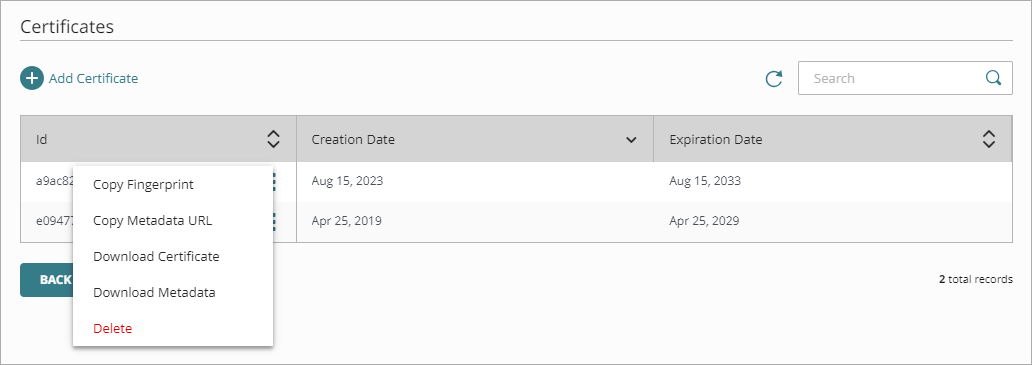
- Log in to the FortiGate 60E web UI at https://<IP address of FortiGate 60E>. The default IP address is 192.168.1.99.
- Select Network > Interfaces.
- Configure the external interface (wan1) and the internal interface (internal2). For information about how to configure interfaces, see the Fortinet User Guide.
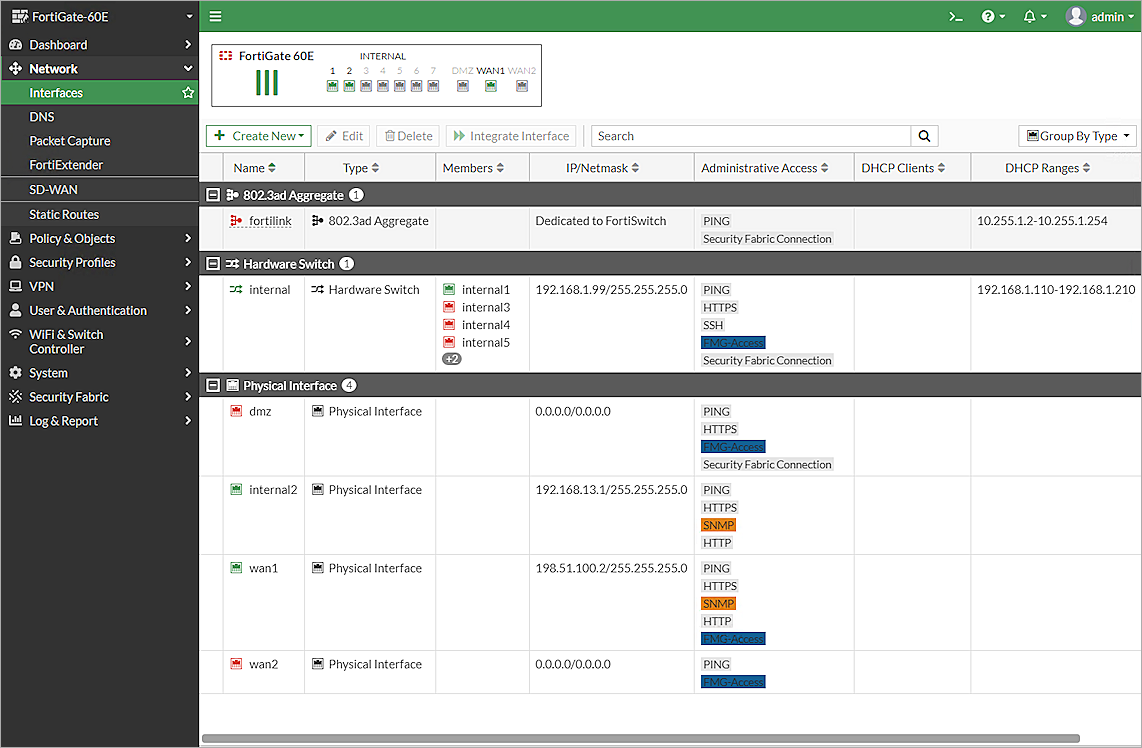
- Select System > Feature Visibility.
- In the Additional Features section, enable the Certificates toggle.
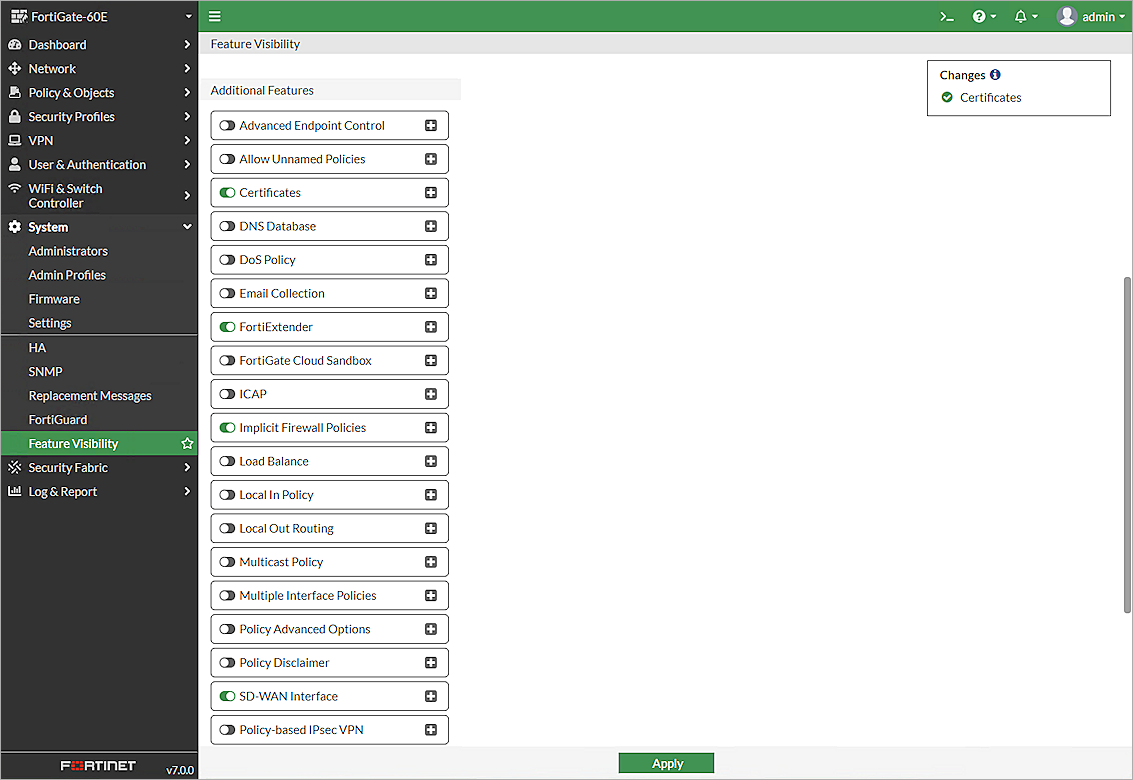
- Click Apply.
- Select System > Certificates.
- From the Import drop-down list, select Remote Certificate.
- Click Upload and browse to select the AuthPoint certificate file that you downloaded in Step 5.
- Click OK.
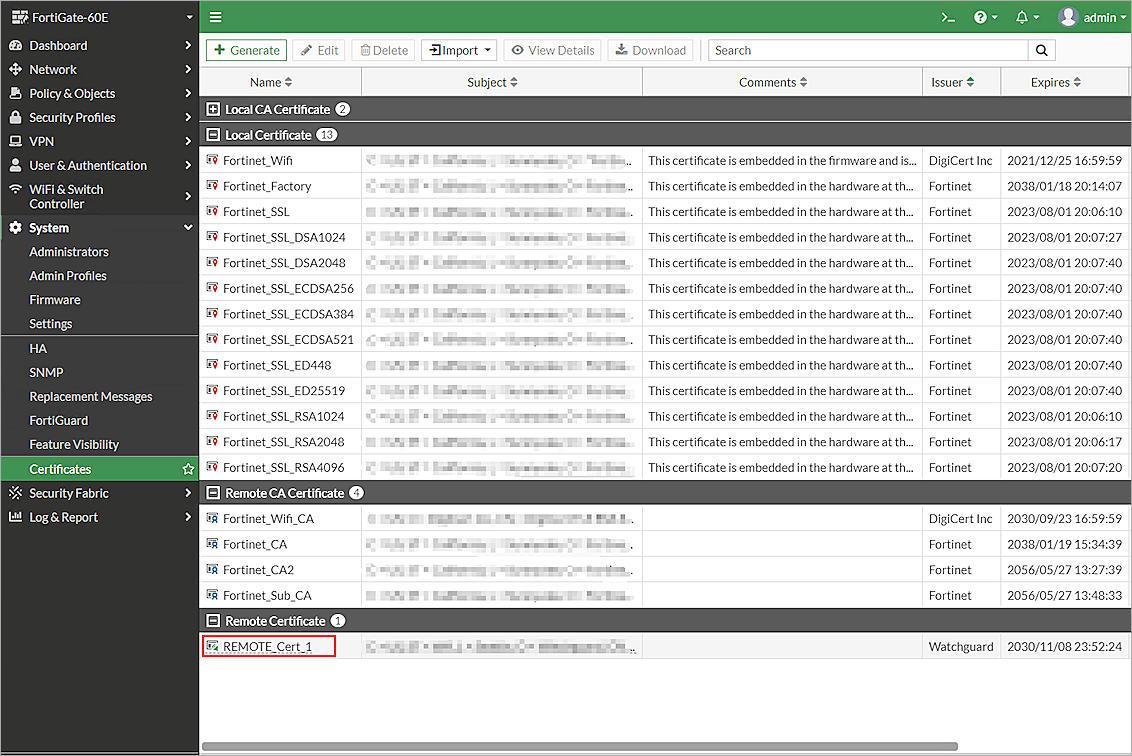
- Configure the FortiGate SP (Service Provider) to be a SAML user. You must use the command line interface (CLI) to do this.
FortiGaate-60E #config user saml
FortiGate-60E (saml) #edit "fac-sslvpn"
FortiGate-60E (fac-sslvpn) #set entity-id "https://<FortiGate external IP address>:10443/remote/saml/metadata/"
FortiGate-60E (fac-sslvpn) #set single-sign-on-url "https://<FortiGate external IP address>:10443/remote/saml/login/"
FortiGate-60E (fac-sslvpn) #set idp-entity-id "<entityID value from the AuthPoint metadata file>"
FortiGate-60E (fac-sslvpn) #set idp-single-sign-on-url "<SingleSignOnService value from the AuthPoint metadata file>"
FortiGate-60E (fac-sslvpn) #set idp-single-logout-url "<SingleLogoutService value from the AuthPoint metadata file>"
FortiGate-60E (fac-sslvpn) #set idp-cert "REMOTE_Cert_1"
REMOTE_Cert_1 is the certificate name of AuthPoint certificate you just uploaded.
FortiGate-60E (fac-sslvpn) #set user-name "username"
This command maps attributes between AuthPoint and FortiGate. You do not specify an actual user name.
FortiGate-60E (fac-sslvpn) #next
FortiGate-60E (saml) #end
- Select User & Authentication > User Groups.
- Click Create New.
- In the Name text box, type a name. In our example, we type saml_sslvpn.
- For Type, select Firewall.
- In the Remote Groups section, click Add.
- From the Remote Server drop-down list, select the fac-sslvpnthat you created in Step 16.
- For Groups, select Any.
- Click OK.
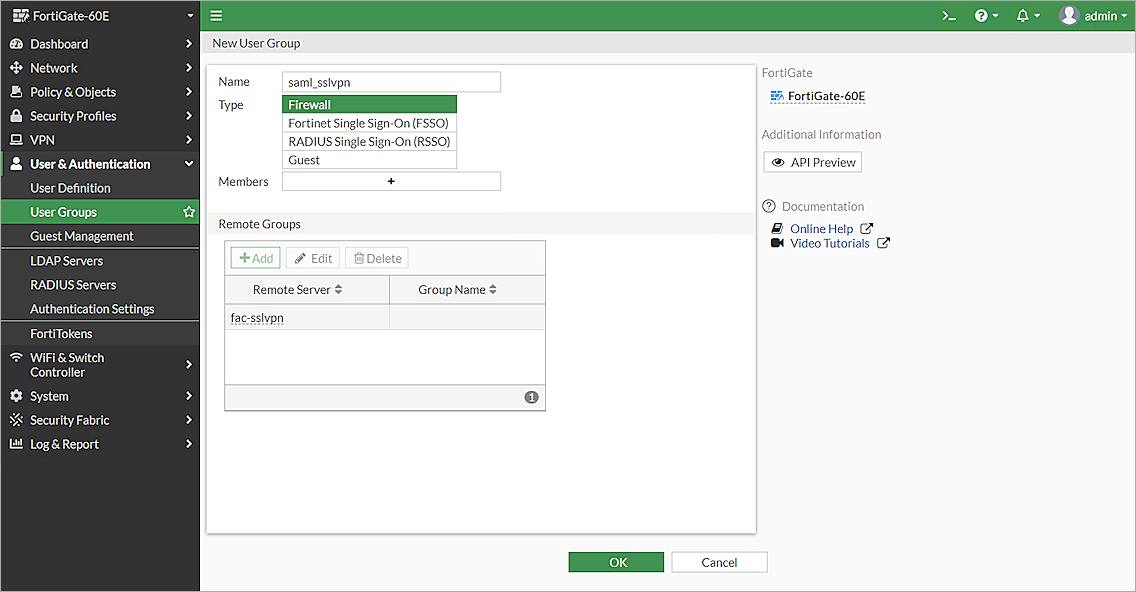
- Click OK.
- Select VPN > SSL-VPN Settings.
- From the Listen on Interface(s) drop-down list, select wan1.
- In the Listen on Port text box, type 10443.
- From the Server Certificate drop-down list, select Fortinet_Factory.
- In the Authentication/Portal Mapping section, click Create New.
- From the Users/Groups drop-down list, select the saml_sslvpn that you created.
- From the Portal drop-down list, select full-access.
- Click OK.
- Select the All Other Users/Groups, click Edit.
- From the Portal drop-down list, select full-access.
- Click OK.
- Leave the default value for all other settings.
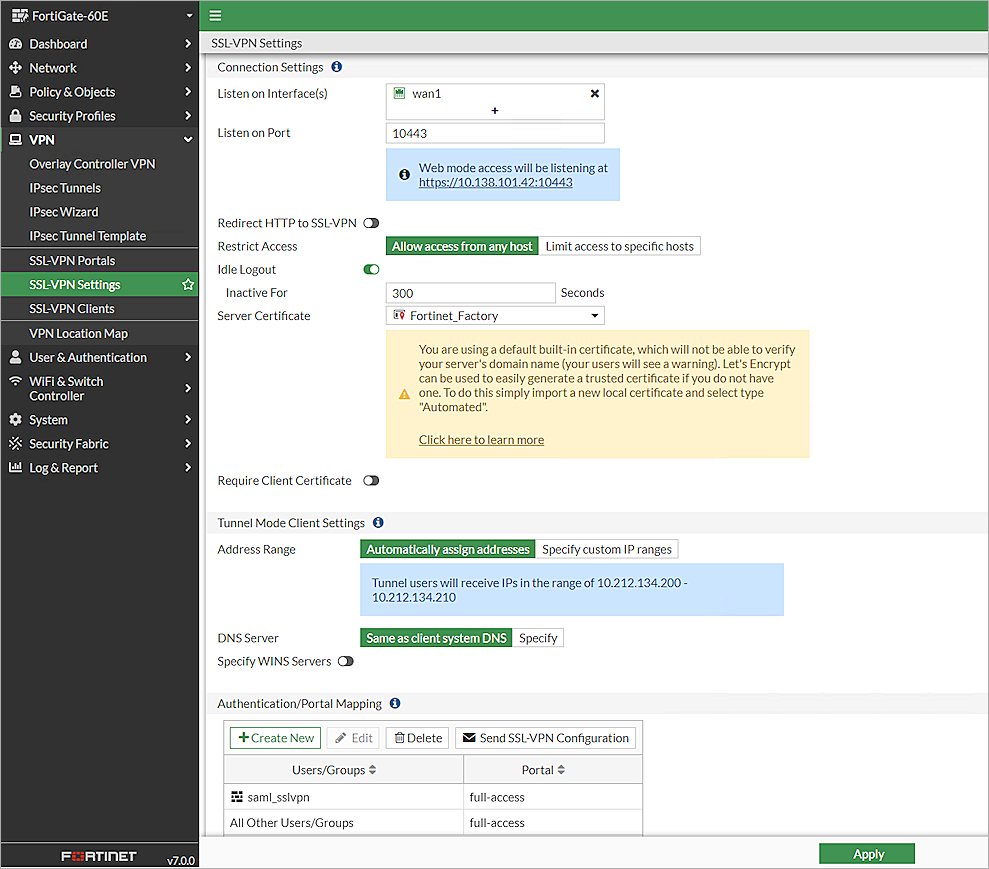
- Click Apply.
- Select Policy & Objects > Addresses.
- Select Create New > Address.
- In the Name text box, type a name. In our example, we type LAN Subnet.
- From the Type drop-down list, select Subnet.
- In the IP/Netmask text box, type the LAN network.
- From the Interface drop-down list, select internal2.
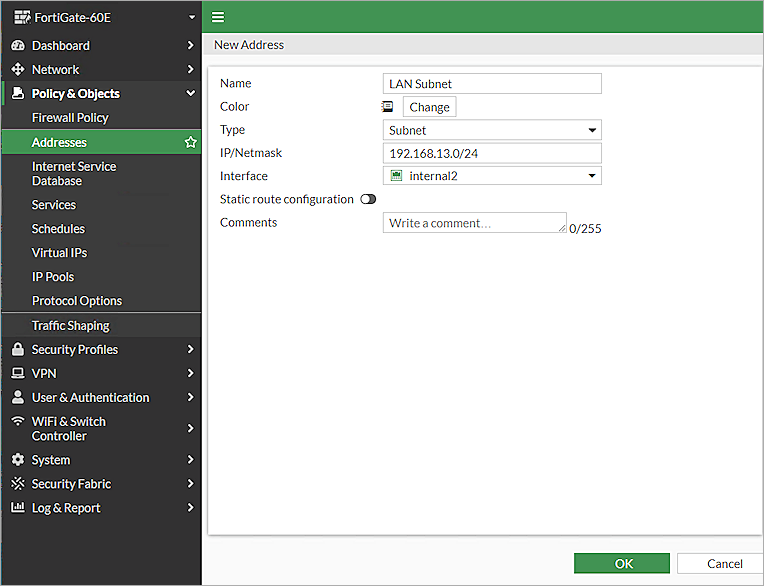
- Click OK.
- Select Policy & Objects > Firewall Policy.
- Click Create New.
- In the Name text box, type a name.
- From the Incoming Interface drop-down list, select SSL-VPN tunnel interface (ssl.root).
- From the Outgoing interface drop-down list, select internal2.
- From the Source drop-down list, for Address, select all. For User, select saml_sslvpn.
- From the Destination drop-down list, for Address, select LAN Subnet.
- From the Service drop-down list, select ALL.
- Leave the default value for all other settings.
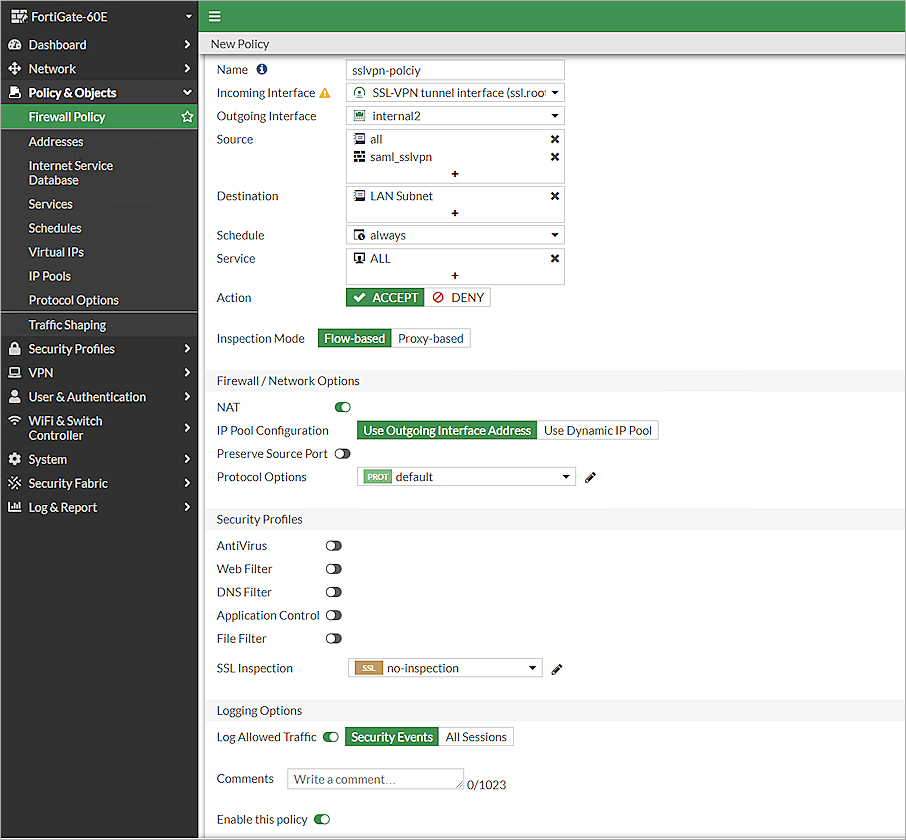
- Click OK.
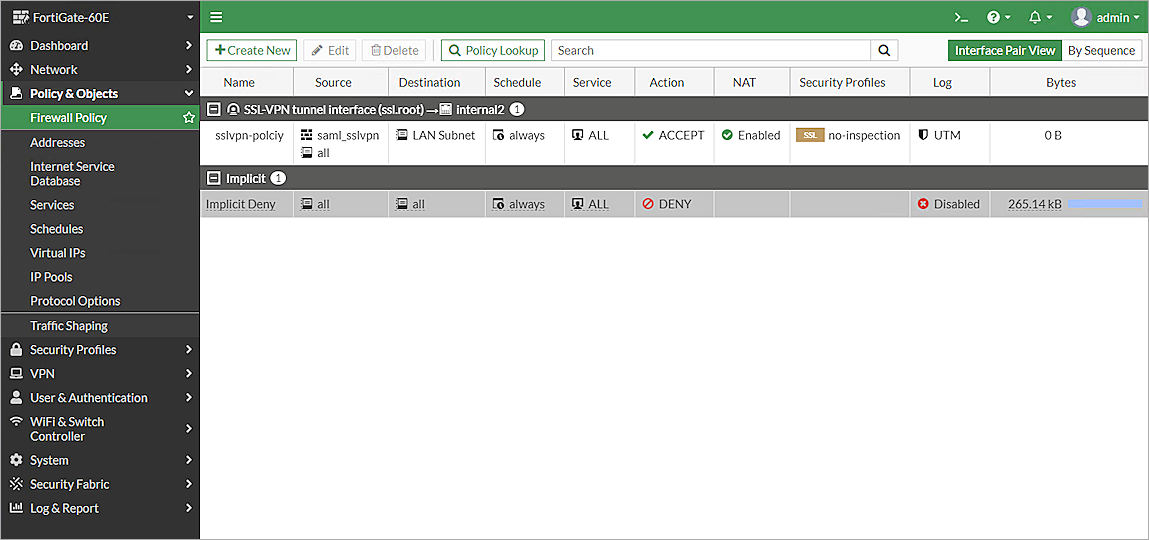
- (Optional) To prevent an authentication timeout with the default time, enter these commands from the FortiGate CLI:
FortiGaate-60E #config system global
FortiGaate-60E (global) #set remoteauthtimeout 60
FortiGaate-60E (global) #end
Configure AuthPoint
Before AuthPoint can receive authentication requests from Fortinet SSL VPN, you must add a SAML resource in AuthPoint. You must also create a Zero Trust authentication policy for the Fortinet SSL VPN resource to determine which users can authenticate and log in to Fortinet SSL VPN and which authentication methods they can use (Push, QR code, and OTP).
Add a SAML Resource in AuthPoint
From the AuthPoint management UI:
- From the navigation menu, select Resources.
Click Add Resource.
The Add Resource page opens.

- From the Type drop-down list, select SAML.
Additional fields appear.

- On the SAML page, in the Name text box, type a name for this resource.
- From the Application Type drop-down list, select Fortinet Fortigate.
- In the Service Provider Entity ID text box, type https://<FortiGate external IP address>:10443/remote/saml/metadata/.
- In the Assertion Consumer Service text box, type https://<FortiGate external IP address>:10443/remote/saml/login/.
- From the User ID sent on redirection to service provider drop-down list, select which user ID attribute to send to the service provider. The service provider compares the user ID attribute for the AuthPoint user with the user name in your application. These values must match.
- From the Signature Method drop-down list, select SHA-256.
- From the AuthPoint Certificate drop-down list, select the certificate to associate with your resource. This must be the same certificate that you downloaded the metadata for in the previous section.
- Click Save.
Add a Group in AuthPoint
You must have at least one user group in AuthPoint to configure MFA. If you already have a group, you do not have to add another group.
To add a WatchGuard Cloud-hosted group to the WatchGuard Cloud Directory:
- Go to Configure > Directories and Domain Services.
- Click the WatchGuard Cloud Directory domain name. If you have not yet added the WatchGuard Cloud Directory, click Add Authentication Domain and select the WatchGuard Cloud Directory.
The New Group page appears.

- In the Groups tab, click Add Group.
- In the Group Name text box, type a descriptive name for the group.
- (Optional) In the Description text box, type a description of the group.

- Click Save.
Your group is added to the WatchGuard Cloud Directory and to AuthPoint.
Add a Zero Trust Authentication Policy
Zero Trust policies specify which resources users can authenticate to and which authentication methods they can use.
You must have at least one Zero Trust authentication policy that includes the FortiGate SSL VPN resource. If you already have Zero Trust authentication policies, you do not have to create a new authentication policy. You can add this resource to your existing authentication policies.
Users that do not have an authentication policy for a specific resource cannot authenticate to log in to that resource.
To configure a Zero Trust authentication policy:
- Go to Configure > Zero Trust. If you have a Service Provider account, you must select an account from Account Manager.
- Click Add Policy.
- Type a name for this policy.
- In the Target section, from the Content drop-down list, select which groups this policy applies to. You can make multiple selections to add multiple groups.
- In the Resources section, select the AuthPoint resources this policy applies to.
- In the Conditions section, select the conditions that apply to this policy. When you add a condition to an authentication policy, the policy applies only to user authentications that match the policy and the policy conditions. For example, if you add a Network Location to a policy, the policy only applies to user authentications that come from that Network Location. Users who only have a policy that includes a Network Location do not get access to the resource when they authenticate outside of that Network Location (because they do not have a policy that applies, not because authentication is denied). For more information, go to About Zero Trust Conditions.
- (Optional) To create a new condition, click Add New Condition. After you create a new condition, you must still add the condition to the policy.
- From the Type drop-down list, select the type of condition to add to the policy.
- From the Name drop-down list, select which condition of the chosen type to add to the policy.
- To add more conditions, repeat Step 6.
If you add conditions to a policy, we recommend that you create a second policy for the same groups and resources without the conditions. Assign a higher priority to the policy with the policy objects. For more information about priority, go to About Zero Trust Policy Precedence.
- In the Action section, select an option to specify whether to allow or deny authentications for the resources in this policy. In our example, we want to allow authentications.
- Allow — Allow user groups in this policy access to the resources associated with this policy.
- Deny — Deny authentications when users in the groups associated with this policy try to authenticate to the resources associated with this policy.
- If you allow access with this policy, select the check box for each authentication option users can select when they authenticate to resources in this policy with MFA.
For SAML resources, if you select more than one authentication option, users must select one of the available options when they authenticate. For example, if you select OTP and Push, users can choose to type their OTP or approve a push to authenticate. You cannot require that they do both.
- Click Save.
Your policy is created and added to the end of the policy list. - Review the order of your policies and adjust as necessary. For more information about priority, go to About Zero Trust Policy Precedence.
Add Users to AuthPoint
Before you assign users to a group, you must add the users to AuthPoint. There are two ways to add AuthPoint user accounts:
- Sync users from an external user database
- Add WatchGuard Cloud-hosted AuthPoint users
Each user must be a member of a group. You must add at least one group before you can add users to AuthPoint.
To import users from Active Directory, Microsoft Entra ID, or an LDAP database, you must add an external identity in the AuthPoint management UI. External identities connect to user databases to get user account information and validate passwords.
- To sync users from Active Directory or an LDAP database, you must add an LDAP external identity
- To sync users from Microsoft Entra ID, you must add a Microsoft Entra ID external identity
When you sync users from an external user database, you can sync any number of users and they are all added to AuthPoint at one time. Users synced from an external user database use the password defined for their user account as their AuthPoint password.
To learn how to sync users, go to Sync Users from Active Directory or LDAP and Sync Users from Azure Active Directory.
You create WatchGuard Cloud-hosted users and groups from the WatchGuard Cloud Directory in WatchGuard Cloud. Directories and Domain Services is where you add shared authentication domains for WatchGuard Cloud devices and services, such as AuthPoint.
Users that you add to the WatchGuard Cloud Directory are automatically added to AuthPoint as well.
You add local AuthPoint users form Directories and Domain Services. You manage the users in AuthPoint on the Users page.
When you add WatchGuard Cloud-hosted AuthPoint users, you choose whether the user is an MFA user or a non-MFA user.
- MFA users are user accounts that will use AuthPoint multi-factor authentication to authenticate. This is not related to the AuthPoint Multi-Factor Authentication license type.
- Non-MFA users are users that will only ever authenticate with a password, such as a service account user. Non-MFA users do not consume an AuthPoint user license and cannot authenticate to resources that require MFA. They can only authenticate to protected resources if the non-MFA user account has a password only authentication policy for that resource.
After you add a user, you can edit the user account if you need to change their account type. When you change a user account from MFA to non-MFA, AuthPoint deletes the tokens and password vault (if applicable) that belong to the user. This action cannot be undone.
Unlike users synced from an external user database, WatchGuard Cloud-hosted AuthPoint users define and manage their own AuthPoint password. When you add a WatchGuard Cloud-hosted user account, the user receives an email that prompts them to set their password.
To learn how to add WatchGuard Cloud-hosted AuthPoint user accounts to the WatchGuard Cloud Directory, go to Add Local Users to an Authentication Domain.
Test the Integration
To test AuthPoint MFA with Fortinet SSL VPN, you can authenticate with a mobile token on your mobile device. For SAML resources, you can choose any method (push, QR code, or one-time password).
In this example, we show the push authentication method (users receive a push notification in the mobile app that they must approve to authenticate).
To connect from the SSL VPN web portal:
- In a web browser, go to the portal address.
- Type your email address or AuthPoint user name. Click Next.
- If required, in the Password text box, type your password.
- For the authentication method, select Send Push.
- Approve the authentication request that is sent to your mobile device.
You are logged in to the SSL-VPN Portal.
To connect from the SSL VPN tunnel mode with FortiClient:
- In FortiClient, select the Remote Access tab.
- From the VPN Name drop-down list, select the your VPN tunnel.
- Click SAML Login.
- Type your email address or AuthPoint user name. Click Next.
- If required, in the Password text box, type your password.
- For the authentication method, select Send Push.
- Approve the authentication request that is sent to your mobile device.
The VPN connects successfully.
